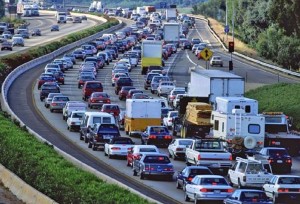It’s been 100 years since Henry Ford switched on the first moving assembly line, kindling America’s passionate love affair with the automobile. But there are growing signs that the romance is cooling – notably including a new study showing that more and more Americans are going carless.
The number of U.S. households going without a vehicle has increased nearly every year since 2007—providing further evidence that motorization may have peaked in the United States, according to research by the University of Michigan Transportation Research Institute, or UMTRI.
“Recent studies have shown that — per person, per driver, and per household — we now have fewer light-duty vehicles, we drive each of them less, and we consume less fuel than in the past,” notes lead researcher Michael Sivak.
Following up on a study UMTRI released last year Sivak found that 9.2 percent of U.S. households were without a vehicle in 2012, up from 8.7 percent in 2007. Further, the proportion of such households increased in 21 of the 30 largest American cities. The university’s findings mirror an earlier report by CNW Marketing which suggested that the number of carless households could soon reach 10%.
“The proportion of households without a vehicle is likely influenced by a variety of factors,” said Sivak, a research professor at the University of Michigan. “Examples of such factors include the quality of public transportation, urban layout and walkability, availability and cost of parking, income and price of fuel.”
Sivak noted in his study that 56% of the households in New York City had no vehicle in 2012. That might surprise few considering the density of the Big Apple’s population and its extensive public transportation network.
But at least a quarter of the households in seven other U.S. cities were without a vehicle in 2012. Second highest was Washington, D.C. at 38%, followed by Boston where the figure was 37%, Philadelphia with 33% of households living without cars, San Francisco at 31%, Baltimore at 31%, Chicago at 28% — and perhaps most surprising of all was the figure for the home of the American auto industry, 26% of Detroit households going without a car.
(Library of Congress creates new registry of historic vehicles. Click Here to learn more.)
Automakers have acknowledged Americans are driving less. However, the industry’s executives have tended to blame the drop on the recession and the fitful economic recovery that followed. For example, Dan Ammann, GM’s new president, said last week that one of the figures he watches closely is not the unemployment rate but the employment rate that counts the number of Americans gainfully employed.
Since the recession, recent college graduates, long a source of new car purchases, have had a much more difficult time finding work than in the wake of past recessions. The growth in the number of part-time jobs and the widespread use of temporary workers also has tended to undercut the ability of Americans to purchase new or even used vehicles, both of which have seen significant price hikes over the last several years.
Poverty in some cities, such as Detroit, has undercut vehicle ownership, while in San Francisco perpetual grid lock has made owning a vehicle more difficult.
(Click Here to see how Millennials are pushing the development of autonomous vehicles.)
The steady growth of the retiree population has also fed the trend. Even car-loving Baby Boomers are “downsizing” and letting go of extra vehicles as their children move away for school or employment.
In addition, more and more Americans are moving into large cities where the cost of owning a vehicle can be prohibitive because of rising insurance premiums and the challenge of finding accessible parking.
The U.S. Census Bureau estimates the population of New York City increased from 8,175,133 in April of 2010 to 8,336,697 in July of 2012, according to the New York City Planning Department, a 2.0% jump. Chicago and Los Angeles also added residents during the same period.
Chicago maintains one of the country’s more extensive public transit systems, making it easier for residents to live without an automobile. But even in Los Angeles, arguably the center of American car culture, city officials are under pressure to increase a rapid transit network that now includes a subway, light rail and express busses on the city main arteries, making easier for residents to keep their vehicles parked.
By and large, however, even urban planner acknowledge that public transportation systems in most of the country are weak to non-existent, leaving a huge population of Americans dependent on automobiles for daily life.
One of the big questions is whether the carless trend will continue to gain momentum, especially as the U.S. economy continues a fitful recovery.
Another question is whether Millennials – who make up the next big wave of potential buyers — will maintain their current indifference to vehicle ownership. Conventional wisdom suggests they’re more interested in smartphones than cars, but a separate new study by Deloitte LLP argues that an overwhelming majority of Gen-Y eventually plan to buy or leaves vehicles.
(Are Millennials ready to go driving after all? Click Here for more on that study.)
But this new generation may be less interested in traditional factors like performance and styling and more focused on finding environmentally friendly vehicles and, in particular, “remaining connected to all of their lifestyle technology when on the road,” stressed Deloitte principal researcher Masa Hasegawa.
(Paul A. Eisenstein contributed to this report.)


With true unemployment still double digit and major corporations eliminating tens of thousands more jobs in the past few weeks, I’m not convinced we’re seeing any real economic recovery yet. $3/gal. gasoline is still a factor in how much people drive.